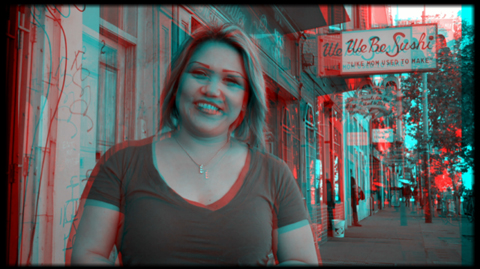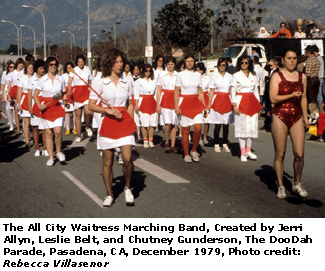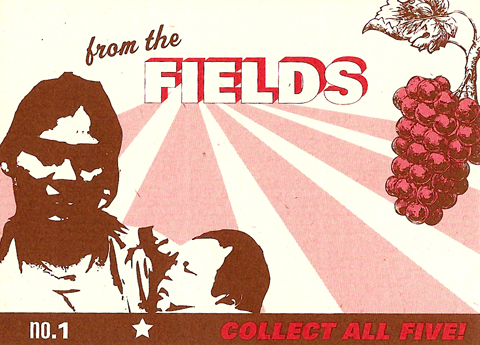Turning the Tables:
New work by Glenda Drew
15 Feb 2011

Image by Glenda Drew
Food for Thought
G LENDA DREW IS A MEDIOGRAPHER WORKING IN ALTERNATIVE and multimedia forms. Originally from the midwest, she spent recent years in the Bay Area as a graduate student of the now-defunct SFSU Interarts Department, as a community-based teacher and graphic media artist making CD-ROMs, video and installations on various topics. She is now an Associate Professor at UC Davis.I first met Glenda Drew (c. 1996) when she was teaching into 'Cyberspace for Women', a multimedia course for Latina artists at ATA. In this newest body of work, Turning the Tables, she continues to merge highly personal social communication with technical skills and an interdisciplinary 'commitment to developing media and technological capacity among marginalized communities.'[1]
Turning the Tables exhibited at the food-based Mission District gallery '18 Reasons' in San Francisco over 2010 summer. It is largely documentary work comprised of 3D photographic portraits with accompanying soundtracks created collaboratively with Jesse Drew, and consisted of two main pieces, Party of Eight and You Are What You Eat. In other related political works shown in Mexico and elsewhere, Drew employs numerous conceptual strategies to engage her audience. For instance, posters of the FDA's "food triangle" reworked to analyze immigrant labor economy. Drew has been documenting local culture near UC Davis and in the community of Chico. New photo-based work on suburban chickens and their owners (in collaboration with Jesse Drew) and typography in trucking culture (in collaboration with Melissa Chandon), for example, was shown recently at the Kodachrome show at Rayko Gallery in San Francisco.
Party of Eight is a "motion-based, asynchronous gallery of contemporary food service workers from a wide gamut of restaurant establishments"[2] In addition to the attractive, black and white frontally shot street-located videos, (requiring 3D glasses for full viewing) where eye movements, hand gestures and physicality of the subjects are a focal point, original voice overs, recorded separately, accompanying each photo by way of earphones. They express "a narrative from the subject's day - as well as the hopes and goals they have for themselves".[3] Audiences listen to and observe a conscientious, playful, and non-objectified subject. The portraits "creat[e] an interpersonal connection between viewer and subject".[4]

from 'Part of Eight', portraits by Glenda Drew
Conceptual Information Art
Especially direct and critical, is the artist's aim to drive her subject matter into unlikely arenas, a tactic resonating (we suspect for similar reasons) with conceptual artists who have long resisted elements of conventional appraisal in gallery space. The theme and thesis of Turning the Tables explicitly raises consciousness about the largely immigrant workforce in American hospitality and food industries. Drew pushes the topic into unexpected geographies using conceptual strategies from installation (food sacks with messages and "potted" video screens) to photographic portraits (the most conventional of her approaches).
In the era of networks, virtual living, iPhone apps, and podcasts, these strategies take on greater meaning as screens become surfaces and surfaces, screens. Screens are seemingly everywhere and ubiquitously located, a radically public space, which when used by artists, might destroy the psychic landscape and fragmented vision imposed by Old Media.
"Scratch and sniff" playing cards and printed informational postcards have been left at dining tables in university cafeterias. Students can take them, read, and respond. Distribution is, thus, split. On the one hand, visible on the Web, and on the other, found in localized, targeted "information" (discussion/awareness). Interventions into "foodie" culture and gallery space (where dining is trendy) suggest some further and perhaps more hard-hitting possible critique in this era of conspicuous, upscale consumption of "organic" and value-added food. Also, the art can be contextualized among similar critical works, such as Ready to Order?a piece about waitress labor designed by Jerri Allyn and artists of the LA Womens' Building c. 1977.

Ready to Order? was a feminist collaboration. Non-art ideas drew attention to a largely ignored, female population of food service workers.[5] Allyn revisited this subject matter again in American Diner(1988)as an installation of self-loaded jukeboxes, literally quizzing their listeners on how much womens' history they knew. (See link below) From Da Vinci to Dada to the post modernist era of independent media, radicalized activists and artists have sought to punch holes in stereotypical images. The tendency to objectify, particularly in mainstream media, the Other, by singling out ethnic and female "workers", for instance, still plagues much storytelling. [We're thinking of a recent kids' film, G-Force--with the secret agent guinea pigs?--in which a very crude stereotype of an African-Latina "worker" is made in the pet shop scene)
In the post-modern era of independent media making and critique of commercial media, activists and artists have sought to create community-based media about underrepresented populations.
Books, clothing, dishes, furniture, public seating, telephones, calling cards, and many other visual "networks" have become surfaces upon which to place alternative information, address public audiences, and send a powerful message. In the era of networked culture, iPhone apps, and podcasts,these strategies take on new meaning as screens become surfaces and surfaces, screens. Screens are seemingly everywhere and ubiquitously located, a radically public space, which when taken up by artists, might destroy the psychic landscape and fragmented vision imposed by Old Media.

Trading card from the series by Glenda Drew
Political .22 caliber
Stifling prejudice towards migrants and immigrants is derailing the so-called 'melting pot' for which the American nation is known. In Turning the Tables Drew draws bede upon the high numbers of Latin American workers in food service industries and bears light upon the Braceros laws (now defunct) created to protect Mexican workers, lending a particularly Californian voice to the intentions of the work. Barbara Ehrenreich's Nickel and Dimed (2000)was a brilliant investigation of the lowest paid American workers serving and cleaning food and motel chains. Ehrenreich demonstrated the inequities of the American economy when it comes to survival, raising children and preventing homelessness on the minimum wage. Drew exposes some of these same inequities and one only wants additional pieces of knowledge, because the food-agriculture-worker relationship and its history of exploitation is so obvious.She wields her camera, like all good documentarians, to create alternative voice, but it is Drew's sheer, uncalculated and loving eye, that distinguishes her art; which serves to dismantle mediated images of Other and to revive the looking eye. The portraits are images of people the artist knows very well in some cases, not a portrayal of the immigrant "class". This raises questions about our own vision and our own social indifference in how we see and treat others, offering a welcome dose of food for thought to the artistic audience.
Through love of subject, Drew raises a kind of precise dialogue about intellectual consciousness, and in so doing, about the essence of mediation itself.
◊
Related works of media art:
Transborder Immigrant Tool project
http://post.thing.net/node/1642
American Diner (Jerri Allyn, 1988)
http://www.seattlepi.com/archives/1988/8801080213.asp
Ready to Order? by Jerri Allen and LA Womens' Building women artists
http://ospace.otis.edu/jerriallyn/The_Waitresses
Links for project:
Turning the Tables http://www.redrocketmedia.com/turn.htmlNorma (Party of Eight) http://www.trickhouse.org/vol11/video/glendadrew.html
Footnotes:
[1] Drew, Glenda.
[2] Tornatzky, Cyane. Video curator. http://www.trickhouse.org/vol11/video/glendadrew.html
[3] Ibid.
[4] Ibid.
[5] Allyn, J. "A Waitress Moment" in Rethinking America: The Arts of Social Change, ed. O'Brien, M. and C. Little. New Society Publishers, 1990.